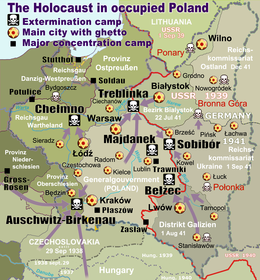Mińsk Mazowiecki Ghetto
| Mińsk Mazowiecki Ghetto | |
|---|---|
Treblinka extermination camp museum | |
Mińsk location south of Treblinka in World War II | |
| Also known as | Mińsk Ghetto |
| Location | Mińsk Mazowiecki, German-occupied Poland |
| Date | 25 Oct 1940 – 21 Aug 1942 [1] |
| Incident type | Imprisonment, starvation, mass shooting |
| Organizations | Nazi SS |
| Victims | 7,000 Polish Jews |
| Survivors | 250 |
| Memorials | The Jewish cemetery in Mińsk |
The Mińsk Mazowiecki Ghetto or the Mińsk Ghetto (
History
Following the September 1939 Nazi-Soviet
Ghetto resistance

The underground resistance formed in the ghetto in mid 1941 and began planning an escape to freedom. Donations were collected for the purpose of buying weapons. A Jewish fund-raising was organized in June and July 1942.

The final wave of mass shootings began several months later. A large group of Jews from the school building (renamed Camp Kopernikus) were transported to the Jewish cemetery on 24 December 1942 and murdered there; those who remained (around 250
At the end of the German occupation of Poland, Mińsk Mazowiecki was liberated not by the advancing Red Army, but by the Polish soldiers of the
Notable individuals
- Polish Righteous among the Nations who presided over Żegota, and sheltered Jews in hiding near Mińsk.
See also
- Pińsk Ghetto revolt
- Łachwa Ghetto revolt
References
- ^ a b c d e f g h i j Alicja Gontarek, historian of the „Biuletyn Gminy Wyznaniowej Żydowskiej w Warszawie” (2014). "On the 70th Anniversary of the Eradication of Mińsk Mazowiecki Ghetto" [W 70. rocznicę zagłady mińskiego getta]. Wojna, Getto, Zagłada. Tygodnik Strefa Mińsk.pl weekly, Jarosław Rosłoniec (Mińsk official website). Archived from the original on October 27, 2015. Retrieved 15 May 2014 – via Internet Archive.
{{cite web}}: CS1 maint: unfit URL (link) - ^ a b c d Justyna Laskowska, Krzysztof Bielawski (2014). "Getto w Mińsku Mazowieckim". Miejsca martyrologii - Zabytki: Mińsk Mazowiecki. Wirtualny Sztetl (Virtual Shtetl), Muzeum Historii Żydów Polskich. Retrieved 12 May 2014.
Stłoczono w nim [w Mińsku Mazowieckim] około siedmiu tysięcy osób [7 000], w tym także przesiedleńców z Kałuszyna, Kalisza, Lipna, Pabianic.
- ^ Museum of the History of the Polish Jews (in English), as well as "Getta Żydowskie," by Gedeon, (in Polish) and "Ghetto List"by Michael Peters at Deathcamps.org (in English). Accessed 23 April 2014.
- ^ a b Justyna Laskowska (trans. Katarzyna Majdan) (2014). "Mińsk Mazowiecki". History - Jewish community. Virtual Shtetl. pp. 6 of 6. Archived from the original on 4 March 2016. Retrieved 13 May 2014.
- ^ a b c d e f g h Małgorzata Frąckowiak & K. Bielawski (2014). "Gmina żydowska dla Mińska Mazowieckiego". Cmentarz żydowski w Mińsku Mazowieckim. Kirkuty.xip.pl. Retrieved 12 May 2014.
- ^ ISSN 0084-3296. Retrieved 12 May 2014.
- ^ Irena 'Jolanta' Sendlerowa, Julian Grobelny i jego żona Helena, FKCh "ZNAK" – 1999–2008. Internet Archive.
- ^ U.S. Holocaust Memorial Museum. "Jewish Resistance in Ghettos and Camps". Jewish Virtual Library. Retrieved 12 May 2014.
- ^ a b "The history of Mińsk Mazowiecki". Polsko-Amerykańska Fundacja Wolnosci (in Polish). Polski Portal Edukacyjny "Interkl@sa". Retrieved 12 May 2014.
External links
- Yad Vashem Photo Archive, Minsk Mazowiecki, Poland, German soldiers abusing orthodox Jews
- Yad Vashem Photo Archive, Deportation to the Minsk Mazowiecki ghetto
- Dariusz Mól (22.08.2012), 70 rocznica likwidacji getta w Mińsku (The 70th anniversary of Mińsk Ghetto liquidation) (in Polish)
- Mińsk Mazowiecki, Poland at JewishGen

